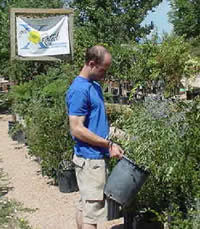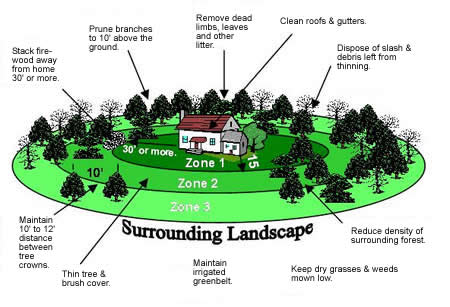Principle #5
Use Appropriate Plants and
Group Them According to Their Water Needs
 The
appropriate selection and placement of plant materials
in the landscape can significantly influence the amount
of supplemental water that is required. The maximum
use of low water use plants will optimize water savings.
It is, however, not always desirable or appropriate
to rely solely on the lowest water use plants. Many
of the more exotic plants that have higher water requirements
can be successfully grown in xeric settings if they
are strategically placed. In fact, the built environment
often drastically alters the natural environment to
the point that many low water plants would not thrive.
Consider the amount of runoff that occurs from a roof.
Low water use plants located in areas where runoff from
the roof increases the average soil moisture content
will grow leggy and unhealthy. The root system may even
rot in poorly drained areas where an exotic plant would
be right at home. The
appropriate selection and placement of plant materials
in the landscape can significantly influence the amount
of supplemental water that is required. The maximum
use of low water use plants will optimize water savings.
It is, however, not always desirable or appropriate
to rely solely on the lowest water use plants. Many
of the more exotic plants that have higher water requirements
can be successfully grown in xeric settings if they
are strategically placed. In fact, the built environment
often drastically alters the natural environment to
the point that many low water plants would not thrive.
Consider the amount of runoff that occurs from a roof.
Low water use plants located in areas where runoff from
the roof increases the average soil moisture content
will grow leggy and unhealthy. The root system may even
rot in poorly drained areas where an exotic plant would
be right at home.
A good planting strategy is key to a successful xeriscape.
Plants should always be grouped together based on their
horticultural needs. If plants have special needs for
sun, nutrients, water, or soil type, microclimates should
be selected or modified to meet those needs. Placing
plants in inappropriate locations will inevitably lead
to plant stress. Stressed plants have less ability to
fight off insects and diseases which will lead to a
decline in their health and may result in an untimely
death.
There are numerous suitable xeriscape plants for every
landscape in our area. These plants offer a wide range
of colorful flowers, foliage, fruits, berries and interesting
textures for all seasons. Local nurseries can guide
you through plant selection for your particular landscape
setting. Remember that the Four Corners region has elevation
differences that will be a deciding factor in your plant
selection. Always inform your nursery person at what
elevation you will be planting.
A “Wildfire
Aware” Landscaping Strategy
Wildfire is a common and natural occurrence
in the Four Corners landscape. In fact, many of
our native plants are fire adapted and need regular
fire events to re-propagate. For homes located in
rural settings or urban areas that interface with
lands that have heavy plant growth, maintaining
an appropriate defensible space around your home
is essential. Many of the concepts that make a successful
xeriscape design will help make your home more defendable
against wildfire. For example:
- The use of larger hardscaped surfaces such
as patios and walkways helps to create fire
resistant buffers around your homesite. Avoid
wooden decks.
- The use of an automated irrigation system
will ensure that your plantings are watered
appropriately and remain healthy, which will
make them more fire resistant. Furthermore,
an irrigation system can be operated in advance
of a fire, enabling the landscape to hold more
moisture and making it more resistant to ignition.
- Thin out continuous tree cover to create
defensible space within 30’ of your home.
- Prune branches to a height of 10’.
- Maintain and clean up flammable materials
within 5’ of your house.
- Maintain a 10’ to 12’ spacing
between tree crowns.
- Avoid planting evergreens near structures.
- Plants near your home should be more widely
spaced and lower growing than those farther
away.
- Plant in small irregular clusters or islands.
- Use mulches to conserve moisture and reduce
weed growth. Fire does not spread readily in
damp mulch.

|
|

